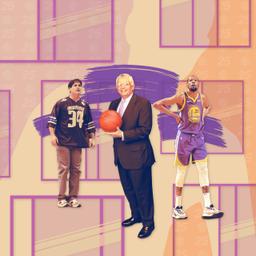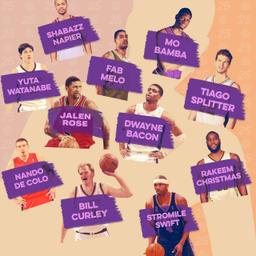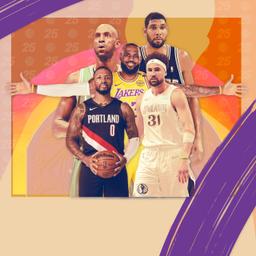It’s NBA Quarter Century Week at The Ringer, continuing our site’s yearlong package examining the best of the best—from movie performances to NFL teams to video games—of the past 25 years. This week, we’re focusing on basketball and some of our favorite people and teams lost to time. We’ve ranked names, celebrated the golden age of mixtapes, pondered the biggest what-ifs, and crowned the greatest non-Finals team of the 21st century so far. Up next, the pioneers.
Players steal moves. Coaches rip off plays. Franchises co-opt entire team-building strategies. The NBA is, rather famously, a copycat league—which means that over a long enough timeline, every good idea eventually becomes copied and copied, until one day it loses all resemblance to what made it so successful in the first place. It also means that there’s a lineage to most everything that happens on an NBA court. The game lives and breathes. All you have to do to understand the dominance of the Thunder or the flow of modern offense is trace them back to the source.
The NBA’s last 25 years have been marked by tectonic changes in style—most of which has stemmed from just five players. Five true Originals. They’re not the five best players of the quarter century; they’re the five that drove the game forward. To fit the bill, a player must meet two specific criteria:
• Did the player feel like something new? It’s usually a tell when comparisons fall short. It’s not enough to be a combination of stars we’ve seen before or a throwback to a different era. An Original has to break new ground—to start a new line.
• Did the player change the game (as opposed to changing a game)? Dominating isn’t enough, nor is being one of one. Calling something an Original implies there’s more to follow. These are evolutionary talents that have redefined how basketball is played.
With those simple requirements, the most talented era in NBA history can be distilled to a handful of changemakers: Dirk Nowitzki, Steph Curry, Draymond Green, Nikola Jokic, and Shai Gilgeous-Alexander. For as singular as Shaq was, he doesn’t quite fit the bill; the way he pulverized defenses was a bit too similar to Wilt Chamberlain, and physically he was too much of an outlier to replicate. How could you even begin to scout for the next Shaq, much less develop him? Allen Iverson shifted the culture of the sport and inspired a generation of crossover disciples, but fundamentally, his own game was grafted on top of what Isiah Thomas and Nate Archibald had already done. Kobe wanted to be Michael too badly to be anything new himself. Tim Duncan and Steve Nash dominated as textbook examples of their respective positions. And LeBron … well, we’ll get to him. These are pantheon stars who earned accolades and built dynasties. Yet in all of their success, they didn’t push the NBA anywhere it hadn’t been before.
For that, it took an import. Dirk Nowitzki is often credited as the premier stretch 4, to the point that he wound up as the visual aid for the term’s Wikipedia page. It’s true, in a sense: Nowitzki brought a kind of shooting to the position that went above and beyond what had seemed possible. But calling Dirk a stretch 4 is a bit of a misnomer, because Dirk wasn’t the stretch—he was the whole system. Take the ball, face up, get buckets. Other shooters (including stretch bigs!) were out there to make space for him. Dirk’s revolution came in what he did with that space, and the way he leveraged the threat of shooting over the top of any defender. There had been low-post threats and high-post threats, but never a forward who carried an entire offense from the nail. So sure—without Dirk, we wouldn’t have a spacer like Jabari Smith Jr. But we also wouldn’t have a forward with the irrepressible shooting repertoire of Kevin Durant.
It’s preposterous, on a certain level, to think that a scoring specimen like KD wouldn’t be an Original. His introduction to the league felt radical—so much so that then-Sonics coach P.J. Carlesimo slotted in a rookie Durant as the world’s lankiest shooting guard. It’s just hard to identify, in his 17 years as a pro, any particular way that KD has spurred the game forward. You can’t just start playing like Kevin Durant, though many have tried. Bigs and wings may borrow from his handle, but what makes KD an all-timer is that he can’t be replicated—that no other human being alive can shoot off the dribble the way he does. And even in doing so, he draws from players like Dirk and George Gervin. Durant is more the culmination of a model than the beginning of one.
Steph Curry is something else entirely. First he broke everyone’s brains—baffled defenders, skeptical coaches, concern-trolling pundits—and then he changed the sport forever. It’s an open-and-shut case, the most self-evident Original of the last 25 years. When you zoom out to see the long arc of basketball history, there will be a stark line separating life before and after Steph’s emergence. It’s not just the 3-point volume, but everything that came with it. The space. The flow. No single player has had a greater impact on what is understood to be a quality shot. Steph rewired the brains of basketball lifers and upended the game on a grassroots level. The momentum of those changes is still playing out in real time. Curry didn’t just catch Ray Allen’s record for the most made 3s in NBA history—he obliterated it. And yet Anthony Edwards, who was drafted and raised in Curry’s NBA, has already made 204 more 3s than Steph did in the same number of seasons.
Curry’s Warriors teams, beyond the titles and the records, were a pivot point in the way we understand certain kinds of players. Every slight guard with the audacity to pull up a few feet behind the arc draws the inevitable Steph comparison. And every mobile, sturdy, undersized big is categorized as the next Draymond Green—an Original in his own right for the way he reshaped modern defense. Green was so unrecognizable as an all-time defender hiding in plain sight that Steve Kerr initially didn’t know what to do with him.
This is a through line for all the Originals: They represent such a departure from orthodoxy that they require a leap of faith. It takes time before coaches and teammates can wrap their heads around how far an Original is meant to go. Nowitzki had a strong advocate in Don Nelson, but even he deployed Dirk as a bit of a novelty. Mark Jackson enabled Steph in certain ways, but also insisted he throw entry passes to Klay Thompson in the post. Every Original seems miscast, until it becomes clear that convention could never hold them. Green, for his part, was a tweener coming off the bench before David Lee went down with a preseason injury in 2014. Draymond took his spot, never gave it up, and created an entirely new player archetype.
The switching, the ferocity, the ability to cover ground—there was no real precedent for the kind of all-encompassing defensive player Green turned out to be. The most common comparison is Dennis Rodman, which feels (1) spiritual, given their shared volatility, and (2) overly generalized, seeing as both Rodman and Green are undersized defensive aces but don’t actually play similar styles at all. Rodman was the sort of chaotic element you’d never see coming; Green stays with you every step of the way. And in that, Green paved the way for players like Ben Simmons, Grant Williams, and even Raptors rookie Collin Murray-Boyles. No one has succeeded in finding anything particularly close to the next Draymond, but that hasn’t stopped scouts and executives from creating an NBA pipeline for tweener bigs the world over. And it certainly hasn’t stopped teams from channeling Draymond and Steph in their own concepts. Every NBA outfit reckons, in some way or another, with the legacy of the Warriors.
Here we should probably acknowledge the potential GOAT in the room. The story of the NBA over the last 25 years is in many ways the story of LeBron James. He is modern basketball’s great constant: the best player in a frankly preposterous number of those seasons. James has won everything there is to win and dominated in every conceivable way. That, however, doesn’t make him an Original. Even before he made the leap to the NBA, LeBron was immediately recognizable as a modern Magic, a riff on Oscar Robertson. He’s the most accomplished point forward the league has ever seen, but he comes from a legacy of players who approached the game in a similar way.
LeBron’s version of do-it-all, heliocentric offense led to the wild production of James Harden and Luka Doncic—but it still drew on models from Robertson and Jordan (and was in the conversation with contemporaries like Iverson, Nash, and Tracy McGrady). He’s part of an evolutionary chain. He just didn’t establish one all his own. James completely changed the way superstars manage their careers and leverage free agency, but that isn’t changing the game so much as changing the business of it. One could argue that his longevity is revolutionary, but that has more to do with how long he plays than how he plays. Is there anything to replicate in just being one of the best players in the world at 40 because you’re LeBron James?
The quality that makes LeBron special isn’t that he necessarily drove the game forward, in a basketball sense. It’s that wherever the game went, he somehow remained one of its best and most dominant players.
Contrast that even with someone like Nikola Jokic, an Original who has changed the way NBA teams think about playmaking and where it comes from. You could trace a faint line from Jokic to someone like Arvydas Sabonis, perhaps, as a playmaking big of his time. But he might as well be a different species. The gulf between Jokic and Sabonis isn’t just scale. It’s the difference between facilitating some plays and running everything. It’s the fact that when you change the scale to that degree—from a big who chipped in three assists a game, at most, to one in double-digits—you change its entire function.
In a world where Jokic is the best active basketball player, teams have been more open to the possibilities of inverting the floor and orchestrating offense through a flexible, roving hub. You can’t point to a single player in history who played like Jokic, but you will know an Original by their copycats. Alperen Sengun is Baby Jokic. Derik Queen is Baby Jokic. Indiana University freshman Andrej Acimovic is Baby Jokic? There is a generation of bigs living and dishing in the wake of everything that Jokic has made possible.
It’s tempting to say, in the warm glow of basketball’s future, that Victor Wembanyama will be next. He is unquestionably new. The experience of just seeing him on a basketball court remains jarring, even two seasons in. It’s just hard to imagine how a player of such incomprehensible proportions could bring about change in the broader basketball world. What can you even take away from a player whose very existence is an anomaly? Whose evolution is being something that no one else can be? Part of being an Original is the impression, foolish or not, that some part of their greatness can be imitated. Other guards can and have looked at Steph, and wondered why they can’t have what he has. Bigs have wondered why they can’t be Dirk, or Draymond, or Jokic. You can’t do that with Wembanyama.
You could, however, strive to channel Shai Gilgeous-Alexander. The reigning MVP isn’t explosively athletic in the traditional sense, and comes in right around the league average in height and weight. There has just never been a human being—in basketball or otherwise—that moves like Shai. Every drive feels avant-garde. The league has spent the last decade trying to create the most possible space within an offense, and found the natural limit for how many 3s a team can reasonably take. The next wave of basketball evolution will lie in how that space is used. SGA is constantly inventing—through feints and footwork—new ways to take advantage of any room he gets. The rhythms of the driving game are changing, and no one has done more to explore them than Shai.
Gilgeous-Alexander knows when he needs to move quickly and when he can take his time. He attacks in fits and starts, and then all at once. The cadence of his game is so funky and unconventional that—like our other Originals—it was hard to project how far he would go. SGA was initially cast as a role player, or a supporting star, or an off-guard who needed a more predictable counterpart. None of that proved out; Shai won the MVP, won the title, and has already moved from finding his place in the league to shaping it in his image.
This incoming rookie class has spent the majority of their lives watching someone like Curry, and internalizing the patterns of his game. A sidestep 3 is now just part of the standard package for any aspiring shooter. What will a generation of kids learn from watching Shai move? How will they absorb his leans and stutters, without even knowing it? Maybe it’s a reach to classify SGA as an Original, for the purposes of our rubric, seeing as Gilgeous-Alexander hasn’t had time to change the game in his image. But he will. Sometimes, you just know an Original when you see one. You see a guard slicing through defenses like paper, captivating at every step. You see a powerhouse team, and the world taking note. You see the best players in the world, coming to terms with what they’ve never seen before.








